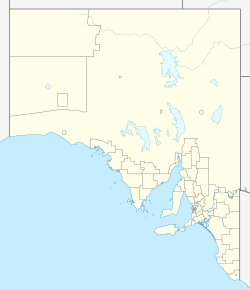Investigator Group facts for kids
| Geography | |
|---|---|
| Location | Great Australian Bight |
| Coordinates | 33°45′S 134°30′E / 33.75°S 134.5°E |
| Administration | |
|
Australia
|
|
The Investigator Group is a collection of islands in South Australia. It includes Flinders Island and five other island groups. These islands are located off the western coast of the Eyre Peninsula.
The group was named by Matthew Flinders in 1802. He was the commander of the ship HMS Investigator. The islands are found within the Great Australian Bight. Most of the islands are protected areas. These include the Investigator Group Wilderness Protection Area and the Waldegrave Islands Conservation Park.
Contents
About the Investigator Group
The Investigator Group is made up of islands and landforms. They stretch about 70 kilometers (38 nautical miles) southwest from Cape Finniss. This cape is on the west coast of the Eyre Peninsula in South Australia.
The islands are listed here, starting from those closest to Cape Finniss:
- The Waldegrave Islands
- The Watchers
- Flinders Island
- Topgallant Islands
- The Ward Islands
- The Pearson Isles
Waldegrave Islands
These are the northernmost islands in the group. They are about 3 kilometers (1.6 nautical miles) from the town of Elliston. This group includes Waldegrave Island (292 hectares) and Little Waldegrave Island (32 hectares).
Their soil is made of a type of limestone called calcarenite. Sheep used to graze here until 1967. Today, you can find native shrubs like Native Juniper and Coast Daisy-bush growing on them.
The Watchers
The Watchers are two rocks located about 3 kilometers (1.7 nautical miles) west of Little Waldegrave Island. They are about 1.8 kilometers (1 nautical mile) apart.
The western rock is about 7 meters (23 feet) tall. The eastern rock is a reef that is covered and uncovered by the tides.
Flinders Island
Flinders Island is the largest island in the Investigator Group. It is about 28 kilometers (15 nautical miles) offshore. The island covers an area of 36 square kilometers (14 square miles).
Flinders Island is used for grazing animals. It has sandy, calcarenite soils. Most of the island is covered with pasture grasses. There are also some areas of heathland and Melaleuca woodlands.
Topgallant Islands
The Topgallant Islands are located 6 kilometers (3.2 nautical miles) east of Flinders Island. This is a small island with very steep cliffs. You can find some small, stunted shrubs growing there.
Ward Islands
The Ward Islands are about 16 kilometers (8.6 nautical miles) west of Flinders Island. These islands are covered with shrubland and heathland plants.
Pearson Isles
The Pearson Isles are the southernmost group of islands. They include Pearson Island (213 hectares), the Veteran Isles (14 hectares), and Dorothee Island (56 hectares).
Pearson Island is the second largest island in the Investigator Group. It also has the highest point, reaching 231 meters (758 feet) above sea level. This island has shrubs, heathland, and patches of Casuarina and Melaleuca trees.
The Veteran Isles have low shrubland. You can find plants like Twiggy Daisy-bush and Marsh Saltbush there. Dorothee Island is the most southerly island in the Investigator Group. It lies 3 kilometers (1.6 nautical miles) south-southwest of the Veteran Isles.
History of Discovery
European Discovery
On February 13, 1802, Matthew Flinders named this group of islands the Investigator Group. He included Flinders Island, the Pearson Islands, the Topgallant Islands, the Waldegrave Islands, and Ward Islands in this group.
Protecting the Islands
Most of the islands in the Investigator Group are protected areas. This helps to keep their natural environment safe. Flinders Island and a part of Pearson Island are exceptions.
South Australian Government Reserves
The Investigator Group Wilderness Protection Area includes Ward Islands, Top Gallant Isles, and Pearson Isles. However, a part of Pearson Island is used by the Australian Maritime Safety Authority for a lighthouse.
The Waldegrave Islands Conservation Park protects Waldegrave Island, Little Waldegrave Island, and The Watchers.
Since 1995, a special agreement has protected a strip of land on Flinders Island. This strip runs along the north coast from Point Malcolm.
As of 2012, the Investigator Marine Park protects the waters around Flinders Island, Topgallant Isles, the Ward Islands, and the Pearson Isles.
Important Bird Area
In 2009, BirdLife International named the Investigator Islands an Important Bird Area (IBA). This means the area is very important for birds.
Many birds live here, including:
- The fairy tern, which is a vulnerable species.
- Large groups of Cape Barren geese.
- Pacific gulls.
- Black-faced cormorants.
The islands are also important breeding grounds for many short-tailed shearwaters and white-faced storm-petrels. The rock parrot has also been seen on most of these islands.



